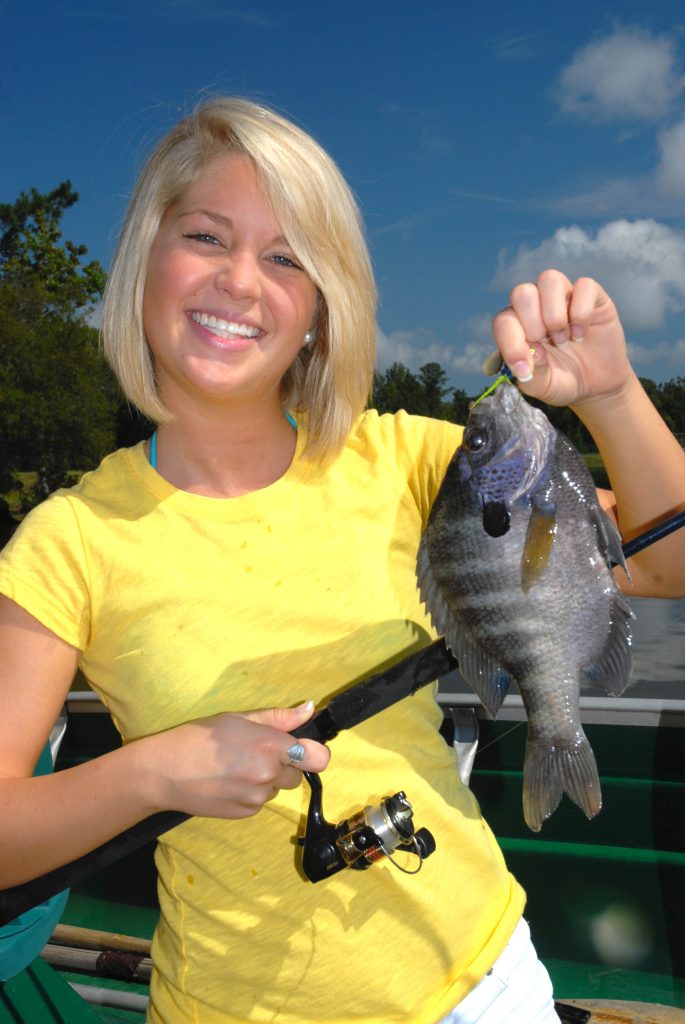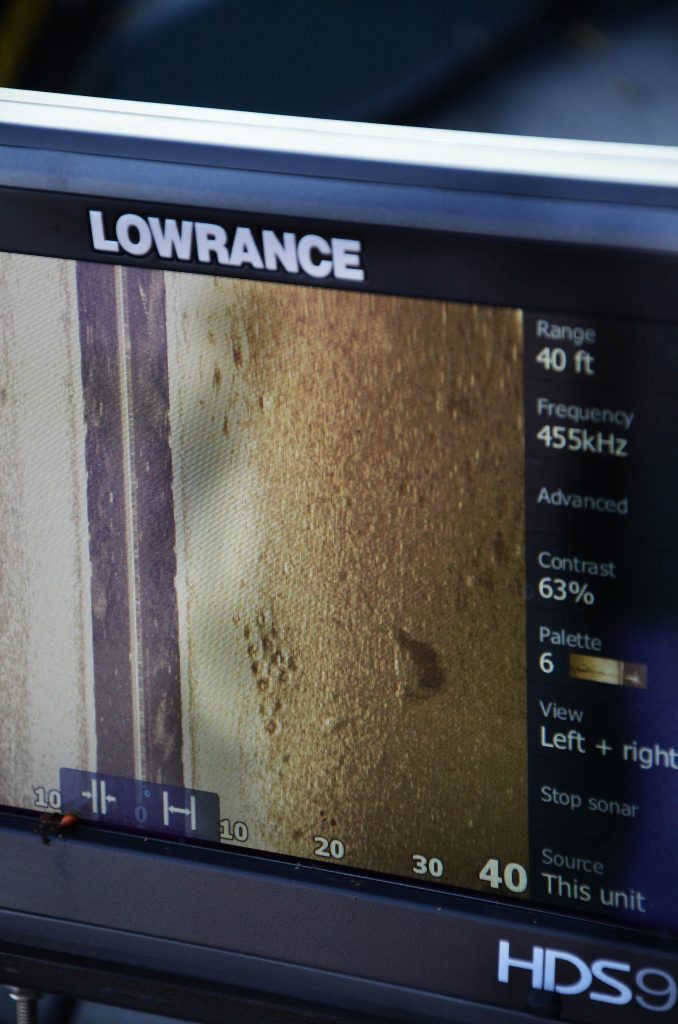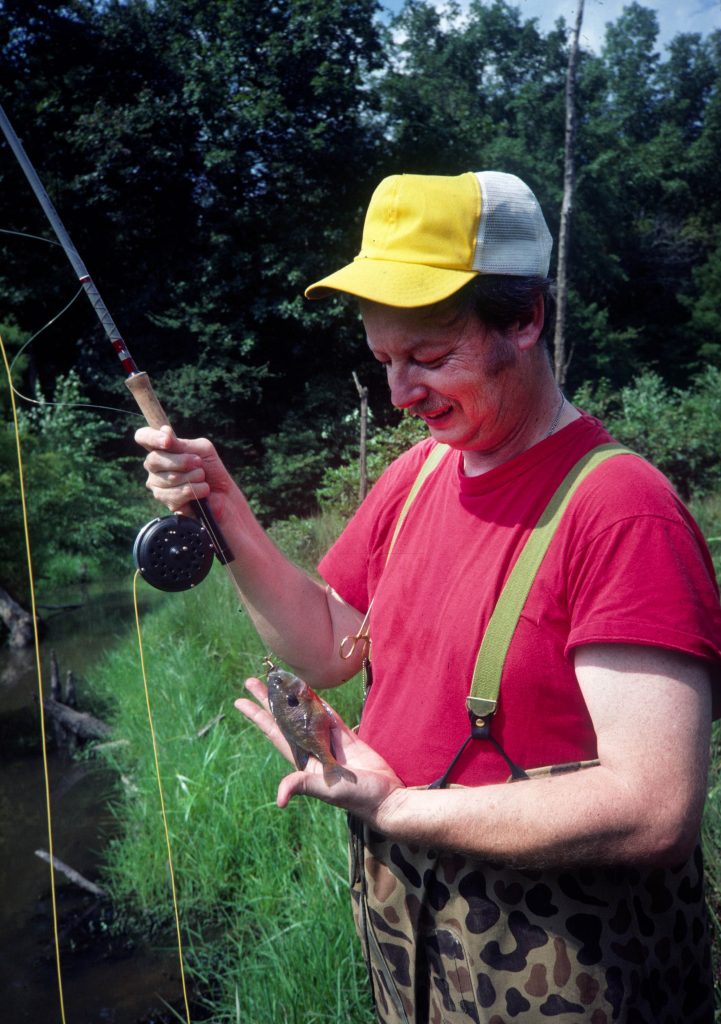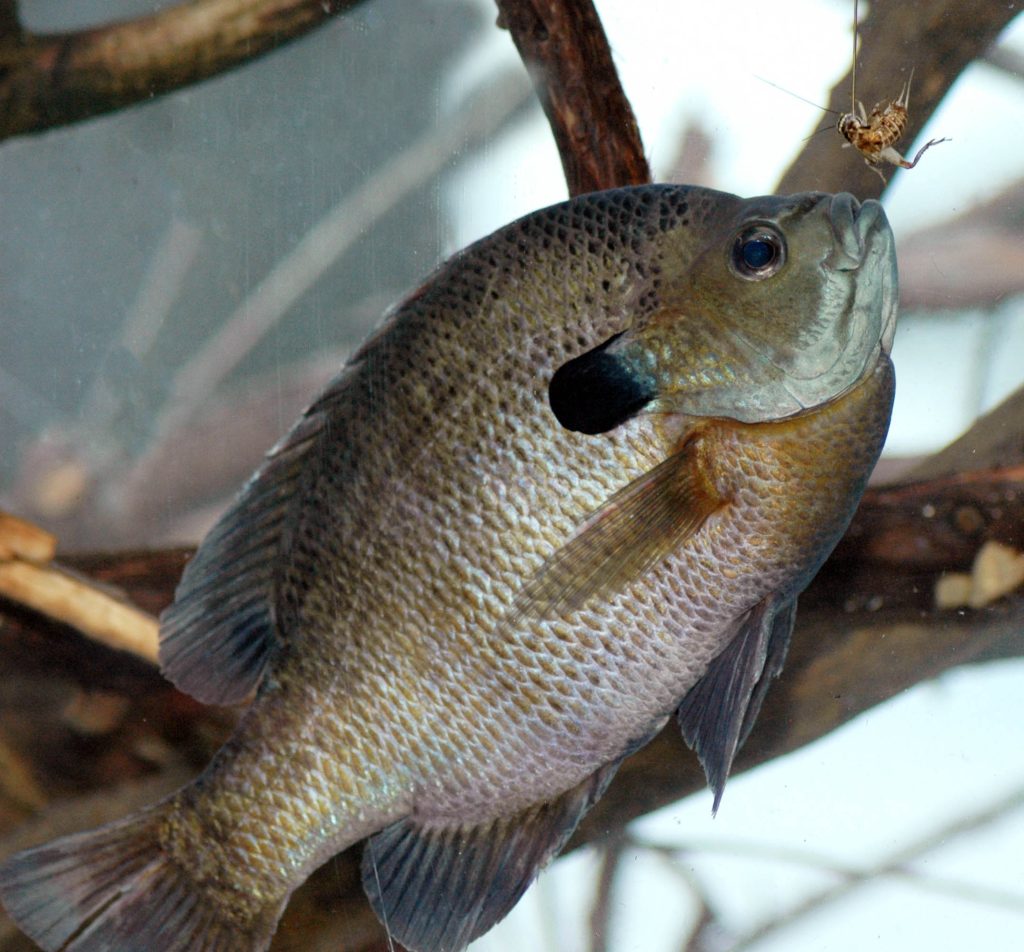Best Bait For Bluegill And Bream Fishing
“To catch the most and the biggest bluegills from any bed, you must pick bluegills just like you pick cotton,” Nathaniel Davis, an elderly outdoor friend who helped me learn to hunt and fish, told me years ago. “You start picking cotton on the plant’s outside first and then work your way into the bolls closest to the stem. That way you won’t knock off any of the bolls. When you’re picking bluegills off a bed, begin on the outside beds first, and work your way into the centers. Once you hook a bluegill, it will run for deep water and away from the bluegills on the more-shallow beds, spooking the bluegills further from the shore,” he said. This wise, older outdoorsman never went to high school, trade school or college. But I never knew a better fisherman or hunter, and I always followed his outdoor advice, especially when it came to picking the best bait for bluegill and bream fishing.
Several modern devices will help you catch more bluegills, including depth finders and GPS receivers. Many bluegill fishermen have learned that if they can locate bluegill beds and mark those spots as waypoints on their GPS receivers, they can return to those sites each year and generally catch bluegills. Thanks to this advantage of better sonar, anglers also are pinpointing bluegill beds where they’ve never located them before. When the bluegills pull off their beds in the spring, they’ll move out to 10 feet of water and hold on rocks, riprap and bridge pilings. By the end of June in the South, many of the larger bluegills have moved to their deep-water haunts to spend the summer, the fall and the winter, before migrating back into shallow water to spawn in the spring. Historically clean banks have been more productive than grass beds for bluegills.
How to Catch Bluegill and Target Areas to Focus On
Farm Ponds
“To catch trophy bluegills, the best place to start is a farm pond that’s heavily fertilized and has a crowded bass population,” explained my friend, Sam Spencer, once the Chief of Fisheries for the State of Alabama. “If you have low numbers of bluegills, then they have more food available and can grow to a larger size. By increasing the number of prey fish in a body of water, you ensure that only a very-small number of bluegill offspring will survive, providing more food for the adults. The water then will home fewer bluegills – but they will be bigger.”
The most-productive farm ponds are generally clear of trees and bushes around them. Also, setting-up an automatic fish feeder with a timer means that when the floating fish food hits the water’s surface, large numbers of bluegills will go on a feeding spree.
Backwaters Off Main River Channels
Smelling bluegills out is what several friends of mine suggest when fishing backwaters. The weed beds, logs, bushes hanging over the water and trees fallen in the water in small creeks, canals, little bays and oxbow lakes coming off major river systems are productive places to find bedding bluegills, often in the same locations year after year. Spawning bluegills in these areas give off an odor like ripe watermelons, and you can follow your nose to pinpoint the bluegill beds. Anglers will use bream poles or ultralight spinning tackle, light line, a red bobber and a small shot lead up the line and bait with live crickets, red worms or nightcrawlers cut into sections.

Catching bluegills like this is easier today than ever before due to new and better electronics.
Rock Piles
Around locks and dams, you can pinpoint visible and/or underwater rock piles in front of the flood gates from the surface or with a depth finder. When scuba diving, I often see good concentrations of bluegills holding in the holes and depressions under and around the rock piles. By using light line, little jigs or live bait and a small shot lead, you can entice bluegills to leave the rocks and attack your bait as it free falls from the surface to the bottom.
Barge Canals
Large riprap with holes and crevices often line a barge canal’s edges where bluegills will hold. Casting to the rip-rap with Beetle Spins, squirrel-tailed jigs and small rubber jigs like the Keystone Minnow, and bouncing them off the rocks will catch bluegills. Anglers sometimes only fish in the first five feet of water out from the rocks. However, barge channels have rocks extending well away from the surface rocks where you also can catch bluegills. Use a depth finder to find brush, and you may catch bluegills there in 10 – 15 feet of water. You also can change to live bait and fish vertically in deep water.
Hidden Locks and Dams
The inundation of old river systems that had locks and dams on them has formed many lakes throughout the nation. Quality lake maps will show the positions of these old locks and dams. You can catch bluegills on the tops of these underwater locks and dams when the fish move closer to the surface and feed on the lip of the break. You also can take bluegills deep on the downcurrent side of these old dams’ wingwalls and barge canals. Because you may experience some difficulty getting your bait down in these regions, if the lake has current running through it, add a split shot up the line away from the bait.
Power Lines
Below many hydroelectric power plants, power lines will cross a lake. These power lines generally sit on man-made rock islands in the water that break the current where bluegills will congregate and provide an eddy area where the fish can feed. Bluegills will bite best when the current runs.

Side-scanning electronics enable anglers to see the bottom and the small, round circles that indicate underwater bluegill beds.
Private Boat Ramps
Bluegills prefer to nest on hard bottoms. When anglers back their boat trailers into the water or are running their boats back up on their trailers, their motors create currents, washing the silt and mud off the bottoms and creating a hard bottom where bluegills can build their beds.
Dam Sites
Although my dad showed me places when I was a boy where I could locate bluegills, once I became a scuba diver, I learned the type of habitat and cover that the bluegills preferred at a dam site, which most pan fishermen overlook. To learn more about where fish live, why they live there, and how they’re positioned on the cover, get into the water with the fish by scuba diving. Here are a few spots I’ve learned from bluegill experts where bluegills like to hang-out at dams.
- A Light Back Current – Bluegills don’t like to feed in strong current. They prefer to lay in wait and let the current bring their food to them. At most dams that generate hydroelectric power, you can see the swift water coming from the base of the turbines at the dam. Often you don’t see the back current that runs back toward the dam and the spillways on the face of the dam where bluegills will concentrate.
- An Offset Like a Ladder or a Break in a Straight Concrete Wall – Many locks and dams have ladders built into the concrete where the lock tenders or boaters can climb up or down to reach the top of the lock or the dam’s side,
- Underwater Rocks Coming in Contact with the Dam’s Vertical Side – Bluegills will concentrate on the back side of a big rock or a boulder in the eddy area of a reverse current and right beside the dam to ambush bait and rest just outside the current.
- Flood Gate Drop-Offs – Below most dams’ floodgates, the concrete runs out into the water for a short distance and then drops-off dramatically to the bottom of the lake. Depending on the time of the year and whether or not the water flows through the flood gates, you often can pinpoint bluegills holding on this concrete drop-off. Even if only a slight trickle of water flows through the flood gates, the bluegills usually will concentrate on the lip of the flood gate drop-off and face into the current.
- The Tops of Underwater Concrete Making up a Dam’s Spillway – Bluegills will feed there, especially when the shad just have spawned. They also will feed above the lip of the break in shallow water on baitfish and insects caught in the light current. When the mayflies hatch, you’ll generally find them swarmed-up against the spillways where the bluegills can capture and eat them.
- The Wing Wall’s Calm Water Below the Current – Casting small jigs, rubber jigs and live bait like crickets, worms and maggots straight at the wingwall, reeling these baits slowly to the wing wall drop-off and allowing the bait to fall will help you catch limits of bluegills.
Today’s new electronics have enabled bluegill fishermen to find more bluegill beds than ever before, especially in deep water in summer, and often in places where other bluegillers fail to look for them. You can catch the most and the biggest bluegills this year by following these ideas from expert bluegill anglers and by using the best bait for bluegill.

Most anglers start-off their fishing careers fishing for bluegills, and when you get older, you still can enjoy those days of singing lines and heavy bluegills.
Catching Bluegills In Winter
A friend of mine several years ago invited me to come with him to catch big, deep-water bluegills in February. I’d never caught bluegills in the winter except while ice fishing at Mille Lacs Lake in Minnesota. Since I’d always thought of bluegills as shallow-water fish, I had trouble believing my friend could catch them in water 40 – 50 feet deep.
My friend told me he’d been fishing in 15 feet of water with a bell sinker on the end of his line and a glitter jig his wife had made tipped with a waxworm up the line. As he fished along the edge of a rocky bluff, he spotted a large school of fish on his depth finder at 48 feet. He dropped his bait down to the bottom, made one turn up off the bottom with his reel and immediately hooked a fish that was a 1/2-pound bluegill. In less than two hours, he’d caught his limit of bluegills.
Starting in the late fall, he then used his depth finder to look for schooling fish throughout the winter and cold weather, often spotting large schools of fish in 45 feet or deeper water. His best baits were crickets and 1/32-ounce glitter jigs tipped with waxworms. He’d hold his boat over the school with a trolling motor and fished vertically for them with six pound-test line and a one ounce bell sinker. These bluegills generally attacked the jigs before the bell sinker reached the bottom. Today, you can go to the Internet and find places to order waxworms year-round.
Bluegill Poppers for Fly Fishing
During the late spring and early summer, you may discover bluegills feeding in the water’s top story at a dam site. I’ve caught as many as 100 bluegills and bream before fly fishing a chartreuse-colored popping bug in front of the spillways and on the slack-water side of dams with my fly rod. Cast your fly toward the dam. Then twitch the fly, moving it away from the dam. Dam bluegills rarely see a fly and will bite quickly. You can fly fish in farm ponds, rivers, lakes and creeks too with small popping bugs to produce limits of bluegills, especially before, during and after a mayfly hatch.

Fly fishing is one of the most-effective ways to catch bluegills when they go on their beds and start feeding in shallow water.
If casting a conventional fly rod seems intimidating, consider picking up a tenkara rod to use for casting poppers. These long, sensitive rods are perfect for casting small poppers and they’re extremely intuitive to use. If you’ve ever spent an afternoon on a creek bank with a cane pole and a cricket cage, you’ll feel right at hope with a tenkara rod in your hand. Compared to traditional, Western fly gear, tenkara rods are affordable and simple, and their unmatched sensitivity means you feel every head shake a bull bream makes as he attempts to throw your popper.
What Do Bluegill Eat
They are omnivorous and will eat a wide variety of foods, including insects, small crustaceans, snails, worms, and even small fish. Insects such as mayflies, caddisflies, and dragonflies are some of the most common food sources for bluegill. They also feed on other aquatic invertebrates such as freshwater shrimp, snails, and crayfish. When it comes to plant matter, bluegill primarily consume algae, but they also eat aquatic vegetation such as duckweed, watermilfoil, and filamentous algae.
That being said, bluegill are opportunistic feeders and will eat whatever food sources are available in their environment. Their diet can vary depending on the season, water temperature, and the availability of food.
Bluegill Lures
Beetle Spin
The Beetle Spin is a classic and highly effective lure for targeting bluegill. It features a small spinner blade attached to a wire arm, with a soft plastic or rubber body resembling a beetle or insect. This combination creates a lifelike presentation that entices bluegill to strike.
The Beetle Spin’s design and action make it an ideal choice for bluegill fishing. The spinner blade creates flash and vibration in the water, grabbing the attention of bluegill and triggering their instinct to attack.
To fish with the Beetle Spin for bluegill, cast it near areas where bluegill are likely to be found, such as around weed beds, brush piles, or along the edges of vegetation. Retrieve the lure with a steady and consistent retrieve, occasionally pausing to allow the bait to sink or flutter, which can trigger aggressive strikes from bluegill.
Mepps Spinner
Mepps Spinners are widely recognized as one of the most effective lures for catching bluegill and various other fish species. These spinners feature a spinning blade attached to a wire shaft, which creates flash and vibration in the water, mimicking the movement of small baitfish or insects.
Mepps Spinners come in different sizes, colors, and blade styles, allowing anglers to choose the most suitable option for bluegill fishing. Sizes such as 0 and 1 are popular choices for targeting bluegill, while colors like silver, gold, and various combinations of bright hues are known to be effective. The blade styles, such as the classic Aglia or the French blade, offer different types of flash and vibrations to entice bluegill.
To fish with Mepps Spinners for bluegill, cast the lure near bluegill habitats, such as around weed beds, submerged structure, or along the edges of vegetation. Retrieve the spinner at a moderate speed, allowing the blade to spin and create a lifelike action in the water. Bluegill are known to strike these lures aggressively, often mistaking them for a small fish or insect.
Panther Martin
Panther Martin lures are highly effective and versatile fishing lures that can be used to target a variety of fish species, including bluegill. These lures feature a unique design that combines a spinning blade and a colorful, vibrant body to attract fish and trigger strikes.
To fish with Panther Martin lures for bluegill, cast the lure near areas where bluegill are likely to be present, such as around weed beds, near submerged structure, or along the edges of vegetation. Retrieve the lure with a steady, moderate pace to create the spinning action of the blade and imitate the movement of prey. Bluegill are known to respond well to these lures, often striking them aggressively.
Bluegill Jigs
- Glitter jigs – Glitter jigs are a type of fishing jig that feature added specks of glitter or metallic flakes in their design. The glimmer and flash created by the glitter or metallic flakes mimic the scales of small baitfish or insects, making the jig appear more enticing to bluegill.
- Popeye Jigs – These jigs feature a unique shape that resembles a small insect or bug, with a rounded body and a protruding lip or “popeye” at the front. Popeye jigs are effective for bluegill fishing because they mimic the natural prey of these fish, such as insects and small crustaceans.
- Rubber jigs – Rubber jigs feature a soft rubber body instead of the traditional metal or hard plastic construction. These jigs are designed to imitate natural baitfish, insects, or other prey that bluegill commonly feed on. The soft rubber material provides a lifelike texture and movement in the water, which can be very appealing to bluegill. The Keystone Jig Minnow made by Renosky is a great example of a rubber jig.
- Squirrel tail jigs – Squirrel tail jigs feature a squirrel tail as the main material for the bait. The squirrel tail is typically attached to a jig head or a hook, creating a lure that imitates the movement and appearance of a small baitfish or insect. The natural fur and hair of the squirrel tail provide lifelike action in the water, mimicking the motion of swimming or wiggling prey.
Best Bluegill Jig Colors
The best bluegill jig colors can vary depending on various factors such as water clarity, weather conditions, and the preferences of the fish. However, some popular and effective jig colors for bluegill fishing include:
- Chartreuse: A bright chartreuse color is known to be highly visible in the water and can attract bluegill’s attention.
- White: A simple white jig can imitate small baitfish or insects, making it a reliable choice for bluegill.
- Black: Black jigs can be effective in low-light or murky water conditions, as they provide a contrasting silhouette that stands out.
- Yellow: Yellow jigs can mimic the appearance of insects or small worms, which are natural prey for bluegill.
- Brown or Natural Earth Tones: Jigs in earthy colors such as brown, tan, or olive can resemble natural food sources and blend well with the surroundings.
It’s important to experiment with different colors to see which ones are most effective in your specific fishing location and conditions. Additionally, consider using smaller-sized jigs to match the size of bluegill’s preferred prey.
Best Bait For Bluegill
The best live bait options for bluegill include:
- Worms: Nightcrawlers cut into sections, redworms, and mealworms are highly effective in attracting bluegill.
- Crickets: Bluegill are known to have a strong preference for crickets, especially during the warmer months.
- Minnows: Small minnows, such as fathead minnows or golden shiners, can entice bluegill to strike.
- Waxworms: These small, soft-bodied larvae are a popular choice and can be used as a single bait or in combination with other baits.
- Maggots: Often overlooked, maggots can be a productive bait option for bluegill, especially when presented on small hooks.
Remember to check local fishing regulations and obtain any necessary permits before using live bait.

Live crickets are one of the favorite natural baits for bluegill anglers.
Bluegill Artificial Bait
- Crankbaits: These lures are designed to imitate small fish or other prey that bluegill would naturally feed on. Crankbaits come in a variety of shapes, sizes, and colors, and are often equipped with treble hooks.
- Spinnerbaits: Spinnerbaits are lures that have one or more spinning blades attached to a wire armature. The spinning blades create vibration and flash in the water, which can attract bluegill.
- Jigs: Jigs are small lures that are designed to be fished vertically or horizontally. They consist of a weighted head and a hook, and are often dressed with a soft plastic or feather tail.
- Worms: Live or artificial worms are a classic bait for bluegill. They can be fished on a hook with a split shot or a small weight to keep them near the bottom.
- Flies: Fly fishing is a popular method for catching bluegill, and there are many different types of flies that can be used. Some popular patterns include foam spiders, poppers, and woolly buggers.
These are just a few examples of the many different types of artificial baits that can be used to catch bluegill. The key is to match the bait to the conditions and to experiment to find what works best in your local fishing spot.
Best Time of Day to Catch Bluegill
The best time of day to catch bluegill can vary depending on a number of factors, including the time of year, the water temperature, and the weather conditions. However, there are a few general guidelines that can help increase your chances of success: Early morning: Bluegill are often most active in the early morning hours, just after sunrise. During this time, they may be feeding actively near the surface of the water. Late afternoon: Another good time to target bluegill is late in the afternoon, just before sunset. As the day starts to cool down, bluegill may become more active and move into shallower water.
Final Thoughts on Bluegill Bait
In conclusion, live baits such as worms, crickets, and minnows are some of the best bait for bluegill, particularly when fished on a small hook with little or no weight. Artificial baits such as small crankbaits, spinnerbaits, jigs, and flies can also be very effective, particularly when fished in the early morning or late afternoon, or on cloudy or overcast days.
When selecting the best bait for bluegill, it’s important to consider the local conditions, including the time of year, water temperature, and weather conditions. It’s also important to experiment with different baits and techniques to see what works best in your local fishing spot.
Overall, whether you’re fishing with live bait or artificial lures, the key to success with bluegill is to present your bait or lure in a way that mimics their natural food sources, and to be patient and persistent until you find the right combination of bait and technique that works best for you.
Full Disclosure: This post may include affiliate links. There’s no extra charge to our readers for using these.
